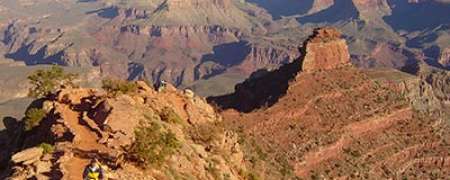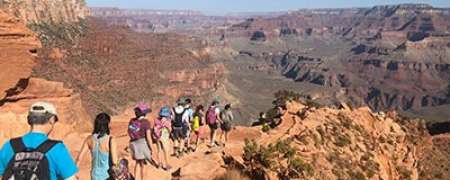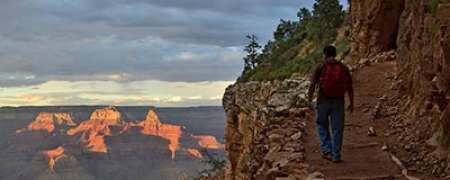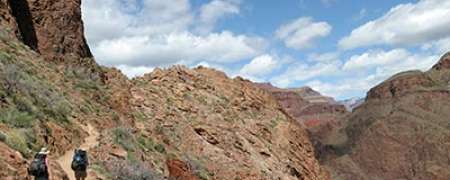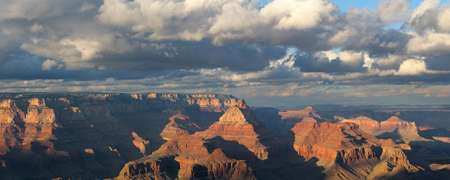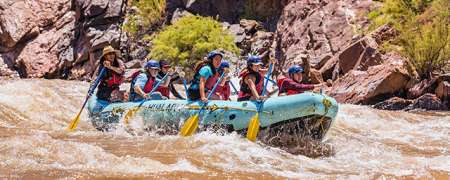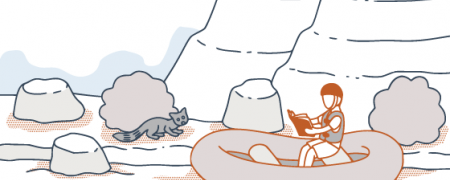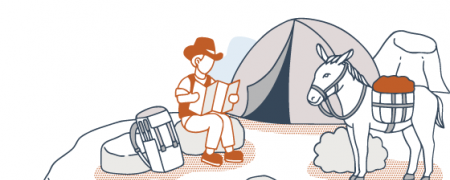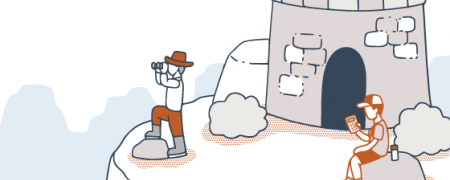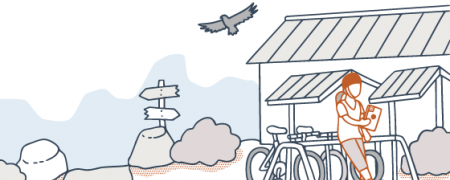Popular Trail Descriptions and Itineraries
Carved out through 5 million years of time by nature's hand, it would not be difficult to believe this awe-inspiring labyrinth was built just for hikers. Stretching 277 miles in length and over one mile deep, you can backpack through 2 feet of snow in the morning and throw on your flip flops in the afternoon. Because it is a network of thousands of canyons, hiking the Grand Canyon still offers the possibility of stomping over virgin earth. From the quintessential Bright Angel Loop hike, to Grand Canyon hiking and rafting vacation packages, the canyon offers a challenge for all who venture below its rim. The grandeur of this Natural Wonder of the World is a hiking utopia, and a place everyone should experience. Below you'll find information on the Grand Canyon's most popular guided hiking trails and get an idea of what a guided tour will be like on these treks.
Havasu Falls Guided Tours
In 2019, the Havasupai Tribe stopped allowing guided trips onto Reservation land. In the past, many people chose to take a guided trip because of the difficult logistics of Havasu Falls trip planning.
But don’t let this stop you from visiting the beautiful turquoise waterfalls of Havasu Canyon! Grand Canyon Guru has all of the trip planning information you need, whether you want to hike, ride a helicopter, stay in a hotel, or camp next to the waterfalls. On our site, you’ll find all of the information you need to plan out all of the necessary logistics, so you are prepared for the adventure of a lifetime! If you want to learn more about Havasupai, check out our Havasu Falls guide.
South Kaibab Trail Guided Hike
Mileage/Elevation /Water
- Trailhead: 0 miles/7,200 ft/Water Mat-Sept (potable)
- Ooh Aah Point: .5 miles/6,320 ft/NoWater
- Cedar Ridge: 1.5 miles/5,200 ft/No Water
- The Tipoff: 4.4 miles/4,000 ft/No Water
- Bright Angel Campground: 6.8 miles/2,400 ft/Year Round Water(potable)
- Phantom Ranch: 7.2 miles/2,546 ft/ Year Round Water(potable)
One of the Grand Canyon’s two most popular hiking trails, the South Kaibab was built for its expansive views. Hikers and mules alike use this trail to get below the Rim. In the early days of Grand Canyon National Park, another popular hiking trail, the Bright Angel, was privately owned through an old mining claim. Although not actively mined, the owners charged park visitors a fee to hike their trail. The Park Service, who was not a fan of this operation, decided to blast the South Kaibab Trail out of a rugged ridgeline to put the miners out of business. The awesome vistas the South Kaibab provided, along with a lack of any extra fee, brought an end to the miner's operation shortly after opening. The trailhead is located east of Mather Point, and can be accessed via a free shuttle service within the Park.
Kaibab, which means “mountain turned upside down,” is the Paiute Indian word for the Grand Canyon. The steep and rugged South Kaibab Trail is one of three major trails that meet at the bottom of the Grand Canyon near the Bright Angel Campground. Starting at 7,200 feet in elevation, you’ll descend through a section of the Kaibab called “The Chimney,” through the first and youngest layer of the Grand Canyon: the Kaibab Limestone. After The Chimney, the trail levels out temporarily, and provides a great view of a 500 million year old cross section of geology. The first major viewpoint along the South Kaibab is aptly named "Ooh Ah Point." Here the Canyon opens up, revealing the grand vistas which the South Kaibab Trail is famous for. From Ooh Aah Point you’ll be hiking another mile to the Trail's next destination: Cedar Ridge. Cedar Ridge is composed of the Supai Group, which is made up of the same beautiful red rocks you’ll see in Sedona, AZ. It is the iron in these rocks that gives them their red color. Cedar Ridge is a great place to catch a glimpse of a California Condor flying overhead, or to hang out on O’Neal Butte and wait for the temperatures to warm up. It is also a nice flat area for lunch, and the last rest stop until you’re quite a bit further down the trail.
From Cedar Ridge it's another 1.5 miles to Skeleton Point. There are no facilities here, but this is your first opportunity to see the Colorado River and Bright Angel Campground. Once you see the sign for Skeleton Point, there's a short trail to your left that will lead you to this magnificent view. Hiking from Cedar Ridge to "The Tipoff" will start with a descent through the Redwall Limestone, which is typically the geologic layer that offers the Grand Canyon’s most formidable hiking. The Tipoff, which is located on the Tonto Platform 4.4 miles down the South Kaibab, is where hikers meet up with the Tonto Trail, and the last rest stop before Bright Angel Campground. From here you have another 2 miles to the Bright Angel Campground, and 2.5 miles to Phantom Ranch.
Hiking from the Tipoff to the Colorado River includes numerous sets of steep switchbacks through the Grand Canyon’s oldest rock layers. Right before crossing the “Black Bridge,” a large suspension bridge hikers use to cross the Colorado, you’ll go through a short tunnel in the Vishnu Schist, the Grand Canyon’s oldest rock, which dates back 1.7 billion years. After crossing the bridge you’ll be hiking past Ancestral Puebloan ruins, and the Boat Beach Trail, en route to your camp along Bright Angel Creek, or Phantom Ranch.
Bright Angel Trail Hiking Tours
Mileage/Elevation /Water
- Trailhead: 0 miles/6,860ft/Water Available
- 1.5 Mile Resthouse: 1.5 miles/5720 ft/Water May-Sept(potable)
- 3 Mile Resthouse: 3 miles/4920 ft/Water May-Sept (potable)
- Indian Gardens: 4.5 miles/3,800 ft/Year Round Water (potable)
- Bright Angel Campground: 9.3 miles/2,400 ft/Year Round Water (potable)
- Phantom Ranch: 9.6 miles/2,546 ft/ Year Round Water (potable)
The Grand Canyon’s most popular hiking trail, the Bright Angel has been used to hike into the Canyon since prehistoric times. The mark of native Grand Canyon inhabitants can still be seen today in the form of ancient pictographs only a short way down the trail. The Bright Angel Trail follows the Bright Angel Fault, which is still active today (although you won’t feel it). This fault helped to break up the rock layers, and create a natural route into the Grand Canyon for both people and wildlife. The Bright Angel Trailhead is located in the Grand Canyon Village on the South Rim next to the Bright Angel Lodge. Before you start your hike, the Kaibab limestone along the Canyon’s Rim here is a great place to find marine fossils, and nearby Kolb Studios usually has some great art exhibits featuring the Grand Canyon.
The Bright Angel Trail is a popular trail for short day hikes, as well as longer day trips to Indian Gardens and Plateau Point. This is also a popular route for hikers on multi-day backpacking trips heading back to the South Rim from Bright Angel, Indian Gardens and other backcountry camping areas. From the trailhead you’ll be hiking down well maintained switchbacks en route to your first rest stop (Mile & ½ Rest House) 1.5 miles down the trail. Be sure to keep your eyes peeled for a pictograph panel located on an overhang to your left about 100 feet before the first tunnel. The next rest stop is another 1.5 miles of hiking down and has taken another very original name: 3 mile Rest House. This is where most Grand Canyon day hikers turn around, especially in the summer heat. Keep an eye out for California Condors, and Big Horn sheep while hiking this first section, as it is fairly common to see one or both of these amazing animals.
Your next stop on this classic Grand Canyon Hike is Indian Gardens. This beautiful Grove of ancient cottonwoods and perennial springs has both a day use area and a backcountry campground. Indian Gardens was inhabited by native people until only a few decades ago when the remaining residents were moved by the Park Service. From Indian Gardens, hikers can follow the Tonto Trail west to Plateau Point, east to the South Kaibab Trail, or continue on the Bright Angel Trail to the Colorado River.
From Indian Garden’s Campground the Bright Angel Trail continues for 3 miles to the Colorado River where it technically becomes the River Trail for the last 2 miles of the hike to Bright Angel Campground. Following Garden Creek you’ll hike the BA through some beautiful Tapeats Narrows until you reach the top of the Devil’s Corkscrew. Although these switchbacks are somewhat notorious, they are not as strenuous as other parts of the trail unless you get stuck hiking them in the hot summer sun. At the bottom of Devil’s Corkscrew, Garden Creek meets up with Pipe Creek where you’ll continue to follow the Bright Angel Trail through the Canyon’s oldest rocks to an up close and personal view of the mighty Colorado River. From here it's 2 more miles of hiking along the Colorado River and a quick suspension bridge crossing to one of the world’s most popular backpacking destinations: The Bright Angel Campground.
North Kaibab Trail Hiking Tours
Mileage/Elevation /Water
- Trailhead: 0 miles/6,860ft/Water Available
- Supai Tunnel: 2.0/3.2 6800/20 Occasional Seasonal Water (potable)
- Roaring Springs: 4.7 miles/ 5200 ft/Water May-Sept (potable)
- Cottonwood Campground: 6.8 miles/ 4,080 ft/Year Round Water (purification needed Oct 15-May15)
- Ribbon Falls: 8.3 miles/ 3720 ft/Year Round Water (purification needed)
- Phantom Ranch: 13.7 miles/2,546 ft/ Year Round Water (potable)
- Bright Angel Campground: 14.1 miles/2,400 ft/Year Round Water (potable)
The North Kaibab trailhead starts from the Grand Canyon’s North Rim at an elevation of 8,241 ft. - over 1,000 feet higher than most places on the South Rim. Aspen Groves, Solitude, and Alpine Meadows make for an experience much different from that of the hustle and bustle of the South Rim and Grand Canyon Village. Less maintained and less traveled, the North Kaibab gives you more of a wilderness experience. This is also a necessary trail for Canyon hikers completing a Rim to Rim backpacking trip. The North Kaibab Trail is a short hike or drive from the North Rim Lodge or the North Rim Campground. There is also a South Rim to North Rim shuttle from Mid May until Mid October while the facilities as well as the road to the North Rim are open.
The entrance to the Inner Canyon via the North Kaibab is through a side canyon that is much more intimate than the expansive vistas located elsewhere along the Grand Canyon’s Rim. The first big views are 1.5 miles down the trail at Coconino Overlook, where more of your future hiking trail is revealed. Another ½ mile down the North Kaibab Trail will bring you to Supai Tunnel, and a quaint little rest stop. The geology of this area is made up of the Red Sandstone of the Supai Group which gives the Red Rock Tunnel its name. Below Supai Tunnel you'll find a few sections of exposed trail, as well as some bridge crossings to help you along your way. From the tunnel, you will have 2.7 miles of hiking before you arrive at Roaring Springs.
You’ll know you're at Roaring Springs when you see water gushing out of the side of a steep slope to your left. Here you’ll see a large structure, which is actually a pump house. The water from Roaring Springs is piped from a few miles below the North Rim all the way to the South Rim of the Grand Canyon nearly 20 miles away. After Roaring Springs another 2.2 miles on the Trail will bring you to Cottonwood Campground. Cottonwood Campground is where most people doing a Rim to Rim hike call it a night. It is also one of only two campgrounds where private stock parties can camp, the other being Bright Angel Campground. Cottonwood Campground is right by upper Bright Angel Creek, and has many great swimming holes and some pretty good trout fishing for those of you with a fly rod.
From Cottonwood it is a quick 1.5 mile hike to Ribbon Falls. Ribbon Falls is a must see destination along the North Kaibab. Both hikers from Cottonwood Campground, and backpackers hiking up from Bright Angel or Phantom Ranch: you should try to make this destination. The last 6 miles to Phantom Ranch will reveal many more wonderful sites, including "The Box," a narrow section of Bright Angel Canyon that crisscrosses Bright Angel Creek for several miles before it opens up near Phantom Ranch.
Bright Angel Loop Guided Backpacking Trip
This is the classic Grand Canyon backpacking adventure. Starting on the South Kaibab, you will descend through 1.7 billion years of geologic history on a trail built for its expansive vistas. Using a suspension bridge to cross the Colorado River, you'll make your way to the historic Bright Angel Campground. After a night of camping under the stars, your hike will take you along the Colorado River, before climbing the Bright Angel Trail to Indian Gardens. Ancient ruins, sunset dinner at Plateau Point, and camping in a beautiful grove of cottonwoods are all part of the second day of your trip. Day three will put you back on the Bright Angel trail. Your hike back to the rim of the Grand Canyon is a great opportunity to spot wildlife, and observe rock art on a path used since the time of the Ancestral Puebloans.
- Number of Days: 3-5
- Distance: 17mi/27km (not including day hikes)
- Elevation Change: 4380ft/1335m
Guided Rim to Rim Backpacking Trip
From the North Rim of the Grand Canyon you'll peer towards a destination that seems lifetimes away. After 24 miles of awe-inspiring views, your arrival at the Canyon's South Rim will evoke a sense of satisfaction rarely experienced in one's lifetime as you turn back to see where you started your journey four days earlier. From Alpine meadows and the Colorado River, to Ribbon Falls and Plateau Point, this hike lets you experience as much of the Canyon as possible in one trek. On this Grand Canyon backpacking adventure, you'll typically camp one night each at Cottonwood, Bright Angel, and Indian Gardens Campgrounds. With unlimited opportunity to explore, and unlimited miles for your hiking boots, this is one of the Grand Canyon's most popular backpacks.
- Number of Days: 4-6
- Distance: 24mi/38km (not including day hikes)
- Elevation Change: 5800ft/1783m
Indian Gardens Guided Backpacking Trip
If you want to relax on your backpacking vacation, and still make it to the Colorado River, this is the hike for you. A more laid-back Grand Canyon hiking adventure, Indian Gardens is great camping experience for first time Canyon hikers and families. Don't worry though - all the beauty and excitement of the Grand Canyon are still at your fingertips. Hiking down the Bright Angel Trail in the footsteps of ancestral Puebloans, you'll make your way to camp at Indian Gardens, where you'll have time to rest or explore close-by ruins. After a relaxing afternoon, your guide will take you to Plateau Point for a sunset dinner at one of the most amazing Inner Canyon views. Free from the weight of your backpack, day two will entail a seven mile round-trip hike to the Colorado River, with plenty of time to rest up for a hearty breakfast and the hike out on day three.
- Number of Days: 2-3
- Distance: 9mi/14km (not including day hikes)
- Elevation Change: 3060ft/933m
